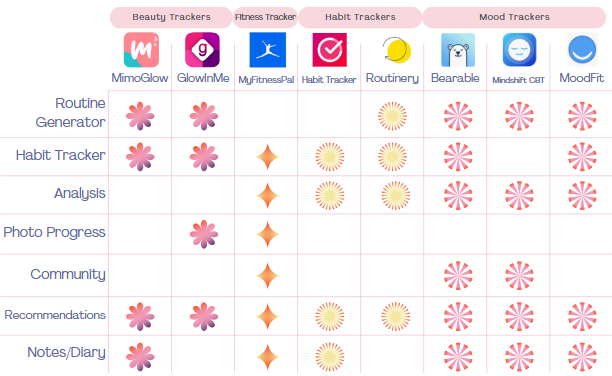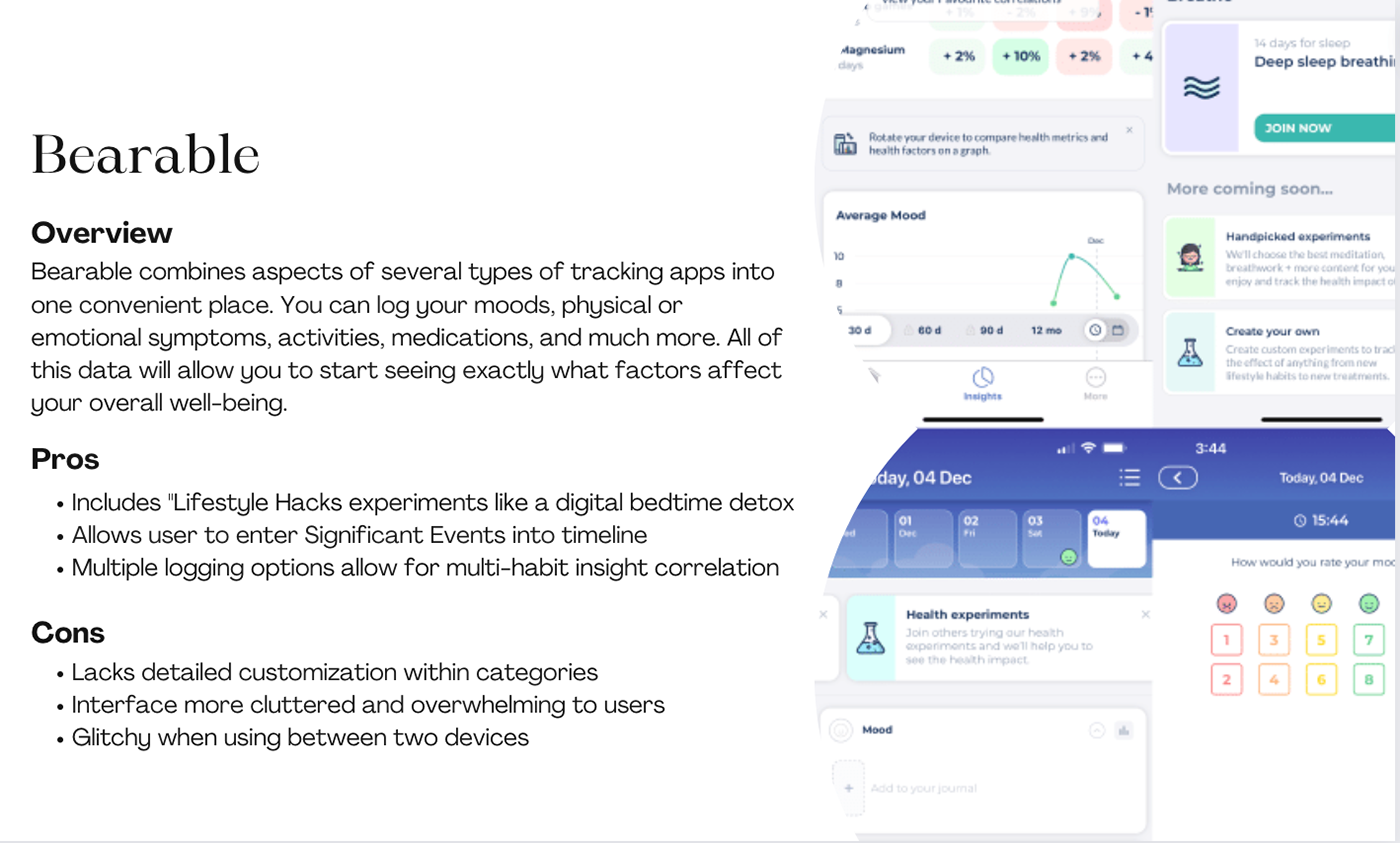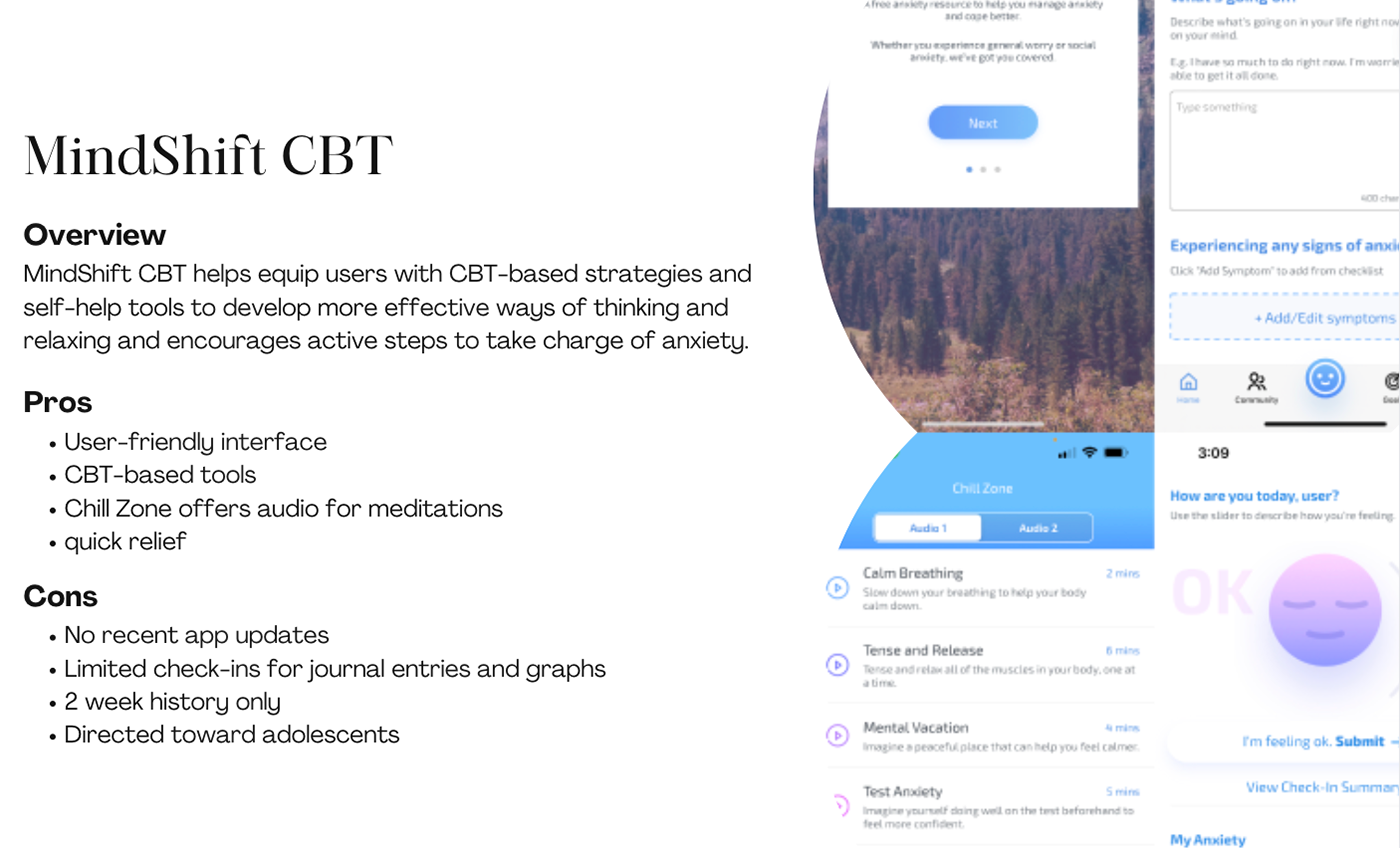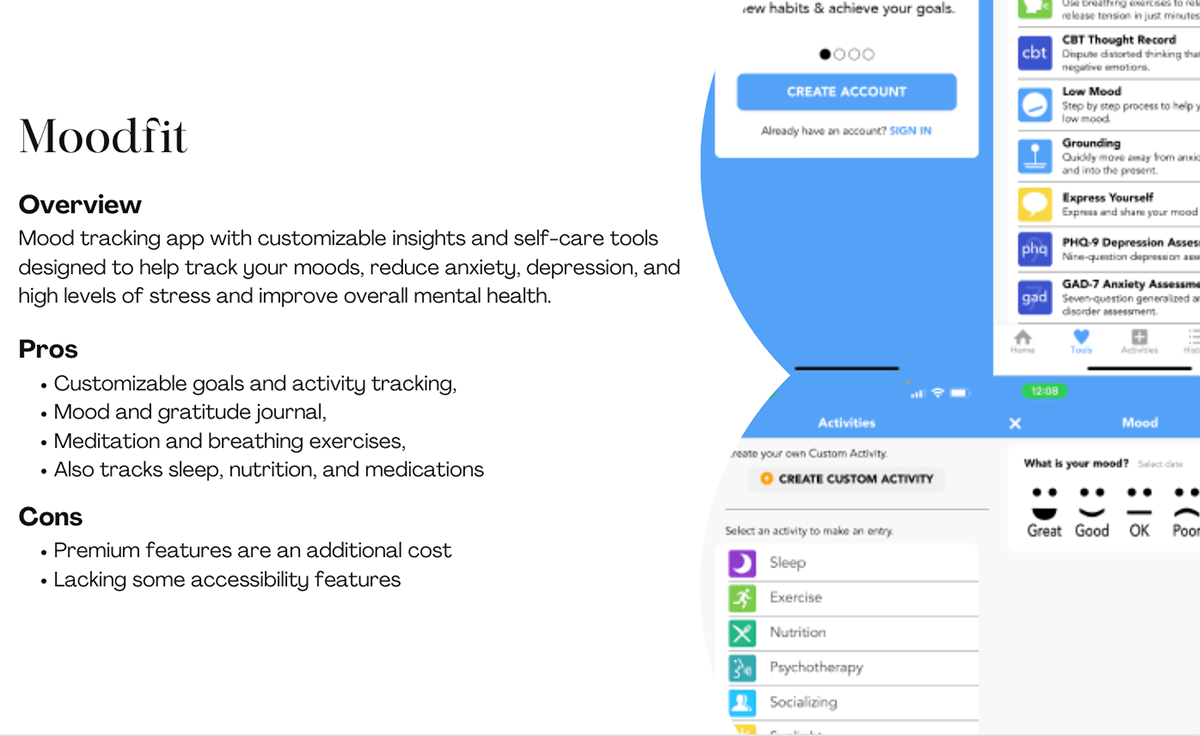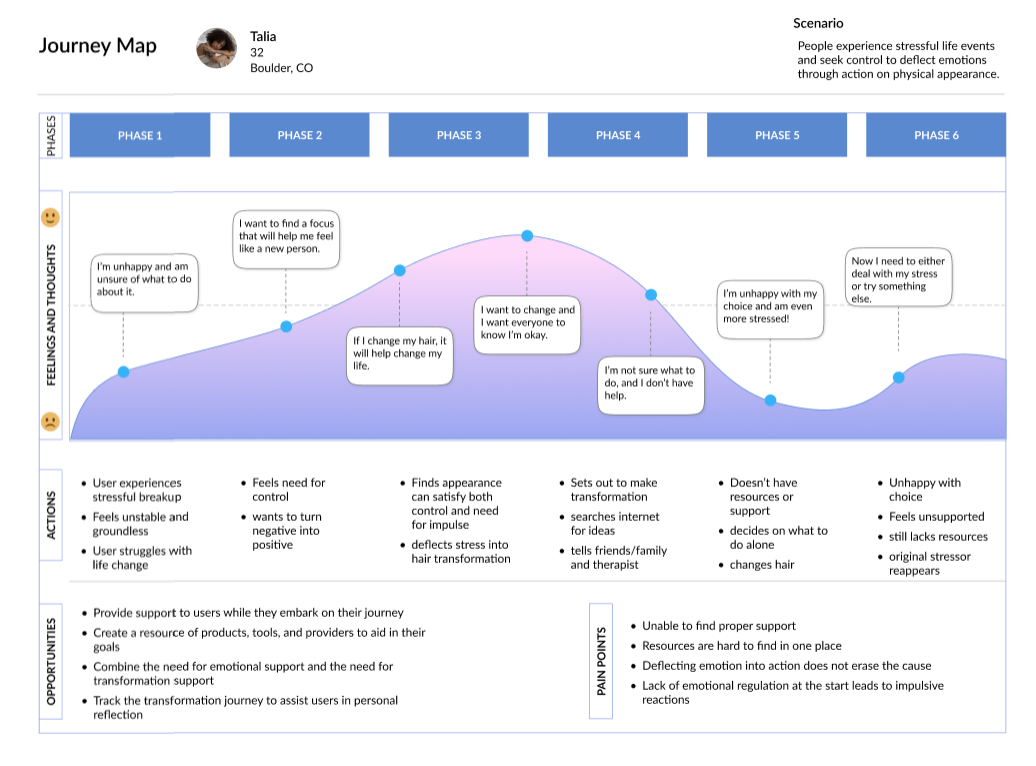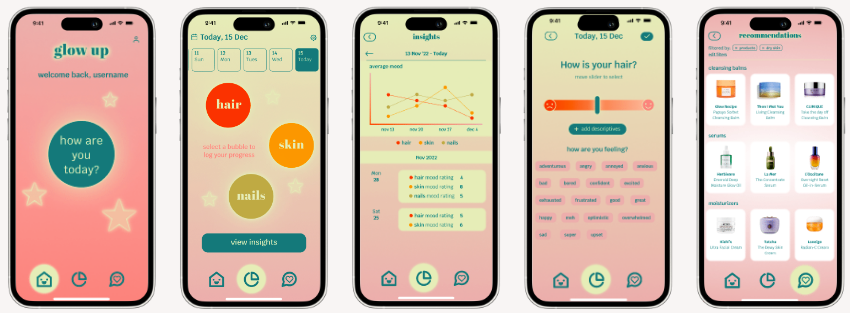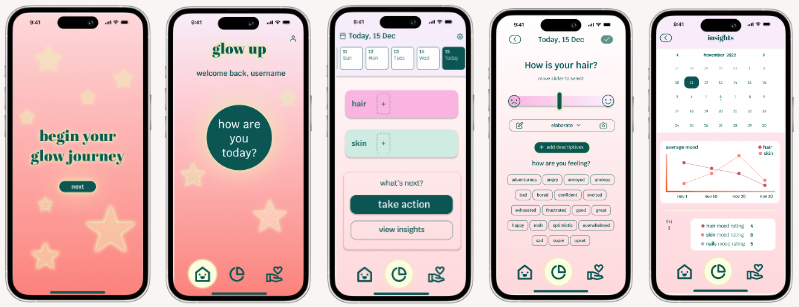"Mood is ultimately a subjective phenomenon, with potential variations in what it means across people."
(Schueller, 2021)
Overview
The root of all self-enhancement efforts lies in emotionally-driven desire for increased confidence and control. While goal and mood-tracking apps may use tools that prove successful for some users, there is yet to be an app focused on combining mood-tracking directly in relation to self-enhancement goals.
Motivation is the key to goal-tracking success, but mood-tracking insights tend to fall short because progress is not as evident, and analysis can only be thorough if users are consistent in tracking their moods in the app.
My goal for this journey was to help users understand the cognitive connection between their physical-mental self and how their emotions and confidence are directly related.
Role: UX Designer [Idea generation, UX Research, Wireframing, Prototying, Brand Application
Scope: 16 weeks
Tools: Figma, Miro, Visme, Canva, Pen & Paper
The Problem
Users that struggle with life events and their mental health use physical appearance goals to gain control but lack the insight to reflect on the correlation.
"People turn to mood-tracking apps to increase self-awareness or self-reflection, especially during challenging times in their lives." (Schueller, 2021)
Strategy
Exploration: Competitive Analysis, User Surveys, User Interviews, Persona, Journey Map
Solution: Wireframes, Usability Testing
Iteration: Prototype
Timeline
Target Audience
Ages 20-50+
People that are interested in mood tracking
Beauty-centric users
Users that care about their physical appearance
Primarily with women in mind
This market is both broad and niche. While many people use tracking apps to accomplish goals or establish trends, not as many are interested in monitoring their physical appearance as a way to project their internal feelings. However, I feel that proper education in the benefits of mood-tracking will grow the demand. Currently my target audience consists of women ages 20+ with interest in beauty and emotional well-being.
Exploration
Competitive Analysis
During my research, I found no direct competitors. Instead, I spread out my scope to include Beauty/Routine Tracking, fitness tracking, habit tracking and mood tracking apps. Each category has features that could be useful, with the most common features being Tracking and Recommendations, and least common features being photo progress options and community support.
Beauty trackers focus more on creating routines and providing recommendations
Fitness and habit trackers focus more on analysis
Mood-tracking apps typically contained all features, aside from photo progress
Diving deeper, mood tracking apps seemed to provide the most information as far as feature efficacy. They tend to rely on Cognitive Behavioral Therapy techniques to give users the skills and techniques to help manage their emotional states.
Bearable was the most robust, allowing users the ability to add goals and qualifying mood states. Their insight analysis feature combines goal progress, averages, symptom scores, and many more. Unfortunately, many users find this app to be cluttered, glitchy and overwhelming.
•MindShift CBT is the most therapeutic of the apps, with many features directed toward anxiety management. Unfortunately their tracking capabilities are limited to only allowing for a two-week history of analysis.
•Finally, MoodFit combines many of the features users find useful. However, the app has limitations for free users, and the interface itself is both overwhelming and lacking the simplicity that many people look for in mood tracking apps.
After reviewing what exists in the market, I decided to focus on an app that combines Goal Tracking and Mood Tracking apps, meshing together the idea of current state tracking and future goal tracking into one.
Through my research, I discovered a formula for creating an effective mood-tracking experience. If a user is provided with enough information and instruction, they will be able to log their moods into the app. Reminders can assist in remembering to do so. Once data is collected, the app can provide visual analysis for users to find patterns and trends. The app will then provide recommendations for users to take action, thus creating a motivational cycle of app-usage success.
User Surveys
To enhance my discovery process, I created a user survey focusing on goal-tracking efforts. I collected 19 responses in a large age range, with a roughly 1/3 male and 2/3 female demographic.
Objective:
Discover user experience with goal-tracking apps and methods
Investigate Feature efficacy in enhancing motivation in pursuing goals
Explore new ideas for decreasing toxicity and promoting body positivity
Method: Anonymous Google Forms
Replies: 19
Questions:
What is your age range?
What gender do you identify?
What country do you reside?
What kind of community do you live in?
Have you ever used a goal tracking app?
What apps have you used in the past?
What are other ways you've used to track goal progress?
What features help your goal progress when using an app?
What features in goal tracking apps do you feel are unnecessary?
If there was a feed of influencers and friends posting inspiration and progress, do you feel like this would motivate you?
In what ways could a goal app avoid the toxicity of the self-improvement culture?
Have you ever used a mood tracking app?
Do you feel like tracking goal progress would be enhanced if paired with mood tracking?
What self-enhancement goals would you be interested in tracking?
Is there anything else you'd like to include regarding tracking your goals using an app?
Results:
16% had used mood-tracking apps
74% had used goal-tracking apps
100% thought a mood-tracking component could benefit goal-tracking efforts
Primarily, users felt apps benefited when they provided personalization options and focused on the individual instead of a community. However, many of these apps were reported to contain too many unnecessary features that led to increased pressure and felt "pushy". And finally, goal-tracking lends itself to potential toxicity, which could benefit from taking away society's idea of beauty standards, and allowing users to embrace where they are through body neutrality.
The most preferred features were:
Daily Logging
Recommendations
Visual Analysis
The most undesired features were:
Community support (as this tends to lead to comparison)
Ads
Articles
User Interviews
For a better understand of the user experience, I chose to focus my user interviews on how some people go through physical transformations as a way to deal with emotional struggles, and what could have been beneficial in their journeys.
Users Interviewed: 3
Age Range: 27-40
Criteria:
Females that have undergone beauty transformations
People that channel their emotions into their appearance
Objective:
Discover how users have experienced stressors in their life in relation to beauty transformations
Examine the triggers that have caused transformations
Explore tools that users feel could have improved their process in dealing with projecting their emotions
Questions:
Do you ever make physical transformations that are caused by life events?
Can you elaborate?
What is your favorite hair transformation you’ve ever done?
How were you feeling during that time?
What were your pain points during that transformation?
What would have been most useful at that time?
Do you feel this app would have been beneficial?
What features do you feel would be the most effective to keep you motivated?
Results:
I discovered every user I interviewed had experienced this. The transformations focused primarily on hair color and cut, but the causes ran much deeper. Users stated they felt a need for control during both stressful life events and normal, everyday stressors, as well as exploring their identity and using their hair for expression.
100% stated that the most beneficial feature for tracking is reflection
66% felt that encouragement is beneficial
33% reported that community support and connection has proved successful
Users feel transformations are "freeing", but also are a result of redirected energy from stressors
"Mood tracking is pretty much why I ever cut my hair. I tend to make decisions about my hair based on stressors in my life." (User 3, 2022)
Persona
I combined all of my interviewed users into one user persona, focusing on finding herself, finding self-care, finding connection, and receiving insight on how she's feeling after a breakup.
Journey Map
The Solution
The solution that came out of this exploration was to create an interface that allowed for reflection on how users were feeling outside as an indicator of how they're feeling inside. It can be difficult to understand how we are feeling, but by providing insights, we can support users by visualizing patterns and creating personalized recommendations and resources.
Create an interface that allows users to visualize how their stress impacts their opinion on their personal appearance.
Provide the ability to translate their mood scores into action with recommendations.
Expand recommendation offerings to include products, video & inspiration, and treatments.
•With a fun design, users will be encouraged to log how they're feeling and be motivated to continue to collect data in order to reflect trends.
Wireframes
Design
Usability Testing
Users Tested: 5
Ages: 23-35
Criteria:
Experience with tracking apps
Interest in beauty
Experience with mental health/therapy
Objective:
Discover how users navigate the workflow
Uncover user opinions on design and interface
•Explore expansion in features that users feel would be beneficial to their emotional experience
Questions:
Please provide your name, age, location, and job description.
What is your experience with goal-tracking apps?
Have you ever used mood tracking apps?
What is your favorite goal-tracking app you’ve used and why?
When you decide on a new self-enhancement goal, describe the trigger point that led to it.
What types of goals have you found are most successful when you track them?
What features do you tend to look for when searching for a tracking app?
What kind of aesthetic do you look for
Task 1:
Imagine that you just downloaded this app and want to set up your new account.
Please follow the screens through to completion.
How did you feel about this task?
Amount of questions? Too many?
Would you use this feature?
Overall, how easy or difficult did you find this task?
Task 2:
Imagine you’re not feeling great and you want to log how you’re feeling about your hair into the app.
Can you show me how you’d do this?
How did you feel about this task?
Overall, how easy or difficult did you find this task?
Task 3:
Imagine you’re struggling with dry skin and are looking for a recommendation for a new hydrating cleansing balm.
How would you go about performing this task?
How did you feel about this task?
Would you use this feature?
Overall, how easy or difficult did you find this task?
Wrap Up:
What do you think about these processes you just went through?
Was the interface easy to understand?
Do you feel this design was made for you? Why or why not?
What was the one thing you liked the most about the design?
What was the one thing you disliked the most about the design?
If you could change one thing about the design, what would it be?
Do you have any other relevant features that this app would benefit from?
Anything else you’d like to add?
Do you have any last min feedback?
Results:
While all of the users tested were able to navigate through the flows with ease, loved the design, and shared that they would use the app, the primary negative trends were lack of information, intention, and clarity. Users understood the need and the direction, but felt the app needed much more clarification.
100% stated they pursue a new self-enhancement goal when influenced by their mental state or social media
100% preferred a "cute" and "aesthetically fun" design
"it just be nice to just be like a little more clear, I guess. Like as to what I'm supposed to be doing in this thing." (User 4)
" I'm not exactly sure what the goal is, but maybe I am. I'm thinking I know where it's less about the actual progress of your hair, or skin or nails and more about the progress of your self outlook." (User 3)
"I don't know much about the the goal of the app like if if we're talking beauty." (User 3)
Key Takeaway 1: Recommendations icon was found to be confusing
Recommendation: Find a better icon that reflected the idea of "providing care options"
Key Takeaway 2: App needs more guidance - onboarding flow options need more consistent description
Recommendation: Add onboarding information screens and make button descriptions more consistent
Key Takeaway 3: Logging homepage was fun but needed a more understandable view
Recommendation: Standardize the view to be less experimental and easier to navigate
Key Takeaway 4: The "nails" section was not yielding positive results
Recommendation: Omit "nails" as a metric and pivot focus to only skin and hair
Prototype
Outcome
Next Steps
Build out the rest of the Recommendations workflow -- videos & inspiration, treatments
Expand the Routine workflow and research other ways this can enhance the app
Do a new phase of Usability Testing on the current iteration
Research ways to grow by connecting with other platforms for more goal mapping
Contact beauty retailers to create partnerships for product recommendations
Explore most effective Insights to reflect visual mapping relationships
Collaborate with mental health professionals to create a more therapeutic experience
Reflection
Spend more time doing preliminary research for a more solid design start
While it's recommended to use lower fidelity wireframes for testing, using colored frames allowed for earlier color palette changes
Initial competitive analysis of goal-tracking apps would have been more effective if mood-tracking was included at that time
Expanding user interviews to include a broader demographic could have led to deeper insights



